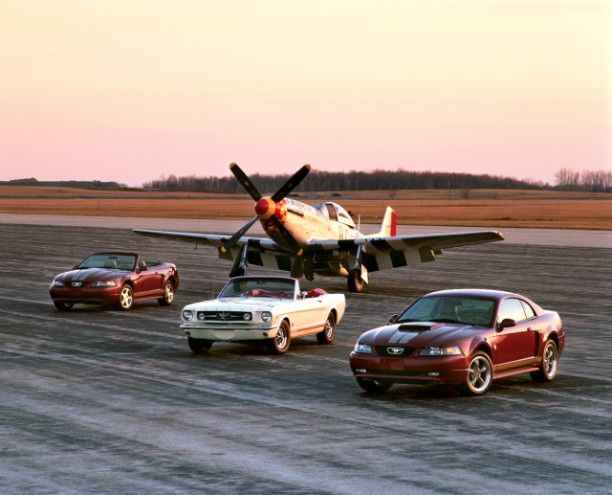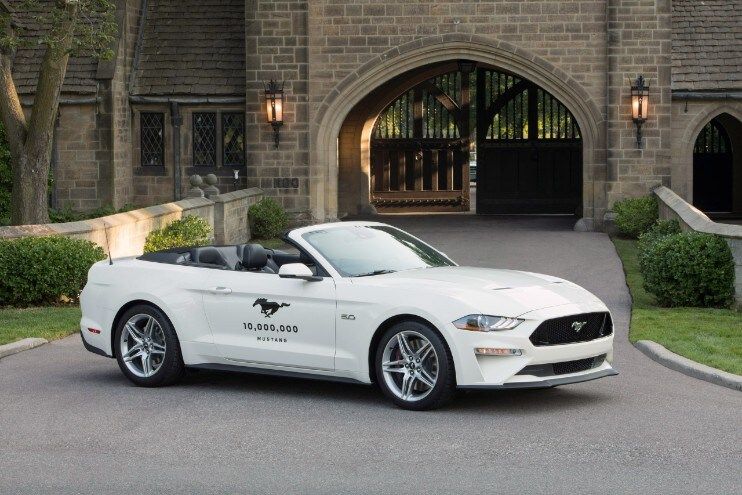Ford Mustang - America's Favorite Pony Car.
The original Ford Mustang was introduced to the public on April 17th, 1964 after an official unveiling by Henry Ford II during New York World's Fair in Flushing Meadows, New York. That same day, the all-new Mustang model galloped its way into Ford dealership showrooms across America where it proved an instant success with approximately 22,000 orders placed immediately. In fact, sales far exceeded what Ford predicted by almost six times. The all-new Ford Mustang appeared on the covers of both Newsweek and Time magazine, and the car appeared in commercials on three major television networks the night before it went on sale. With a stylish design that included a long hood and short rear deck, the Mustang was a car all its own with a starting price tag of $2,368. Because the Mustang launched a few months early, early production models are often called 1964 1/2 models by enthusiasts, although they fall under the 1965 model year on paper and VIN.

The Ford Mustang was the first vehicle to create its very own category - the "pony car". Within a few years, competitors with Chrysler, GM, and AMC followed suit and building pony cars utilizing Ford's formula. Named after the World War II fighter plane, the Mustang was built largely to compete against the Chevrolet Corvair. While the Mustang became one of the most popular and top-selling vehicles ever built, the rear-engined Corvair flailed. Ford called the Mustang the "working man's Thunderbird".
Lee Iacocca was monumental in the creation of the Ford Mustang. Having worked his way up the ranks at the Blue Oval, he eventually found himself in the president's chair. Knowing that Ford needed something special that would help the company bounce back after a difficult stretch during the 1950s, the idea for the Mustang was born. After holding a heated contest with Ford's designers, Iacocca personally picked a sketch by Gale Halderman, one of the Mustang designers that worked under Oros. Some credit Halderman as the sole designer of the Mustang as his sketch is very close to the original production Mustang.
Today, the Mustang has been in production for over 50 years continuously and has six-generation changes under its belt. The pony car remains incredibly popular, and the newest models make ample power straight out of Ford's factory gates.
Generations
First-Generation (1965 - 1973)
The original first-generation Ford Mustang sent shockwaves across America (and the world) after its unveiling in April 1964. Now in a class all its own, the original pony car was produced from 1965 through 1973 with the the first-generation Mustang sporting a long hood and short deck.

Initially, the Mustang was offered in both hardtop and convertible models. In August 1964, Ford began selling a fastback version. Considered compact, the Mustang shared the same platform with the Ford Falcon.
Each time the Mustang was given a redesign, the two-door sports car became bigger and more powerful. For the 1971 model year, the Mustang was given its first drastic makeover, but sales were still dwindling so Ford decided to start on the design for the second-generation Mustang. The 1973 oil crisis had buyers opting for smaller cars with better gas mileage, and Ford was ready to launch the second-generation Mustang for the 1974 model year. Now called the Mustang II, the car looked nothing like its predecessor.
Second Generation: Mustang II (1974 - 1978)
Marketed as the Mustang II, the second-generation Ford Mustang was introduced in September 1973 for for the '74 model year alongside the oil embargo in 1973.

Available in both two- and three-door versions, the Mustang II could sit four passengers. Although smaller, the Mustang still was powered by a front-mounted engine and rear-wheel-drive. Obviously much smaller than prior models, the Mustang II was 490 pounds lighter and about 19 inches shorter. Not, it shared the same platform as the subcompact Pinto, but only a small amount of chassis and driveline parts. The Mustang II was equipped with a unique unibody, independent front suspension, and engine mount subframe. Steering was improved thanks to a rack-and-pinion.
Some enthusiasts may refer to the Mustang II as the "redheaded stepchild of Mustangs", but sales were strong over its four-year production with over 1.1 million of these cars sold. Even more, the Mustang II was named Motor Trend's 1974 Car of the Year.
Third Generation: Fox-Body (1979 - 1993)
Commonly referred to as the Fox-Body, the third-generation Ford Mustang was produced from 1979 until 1993, and it was (and still is) one of the most popular body styles. Built on Ford's Fox platform, the car featured a variety of sub-models, drivetrain combinations, and trim level combinations during its 14 years of production.

For some time, there was talk of replacing the rear-wheel-drive Mustang with a Mazda front-wheel-drive platform. Thanks to consumer opinion, the higher-ups at Ford were convinced to keep the Mustang pow. Instead of replacing the Mustang, Ford introduced an all-new new front-wheel-drive model called the Probe.
The third-generation can be split into two by enthusiasts by the headlights. Cars produced from 1979 through 1986 have been given the nickname "four-eyed" Fox-Body due to the distinctive quad-headlight setup. From 1987 through 1993, the Fox-body featured aerodynamic composite headlamps with a different front fascia.
Fourth-Generation: SN-95 (1994 - 2004)
The fourth-generation Ford Mustang had a ten-year production run from 1994 through 2004. For the first time in fifteen years, the Mustang received a major overhaul. This new Mustang is widely referred to as the "SN-95", an updated version of Fox platform it now sat upon. Introduced in November 1993, the car officially went on sale on December 9th. The Mustang said goodbye to a boxy body and hello to a more futuristic look with curves. Hatchbacks and notchback versions were no longer available, but the convertible returned. The fourth-generation can also be split into two segments with the 1999 through 2004 model years featuring an updated body style known as the "New Edge".

Fifth Generation: S197 (2005 - 2014)
The fifth-generation Ford Mustang was majorly overhauled and given a more"retro-futuristic" appeal with cues reminiscent of the original pony car. The new design was a success as Ford sold over 300,000 in the first two years. Produced through the 2005 through 2014, the fifth-generation Mustang sat on an all-new platform called the S-197. In 2010, the car was given a fresh facelift. In the 2011+ model years, the car featured the modular 5.0-liter Coyote V8 (Gen 1) as an engine option instead of the three-valve 4.6-liter that powered the SN-95 GT models and the earlier S-197s.

Variants of the fifth-generation Ford Mustang include the Mustang GT/California Special, Shelby GT500 and Shelby GT, Bullitt Mustang, and Boss 302.
Sixth Generation: S550 (2015 - Current)
The sixth-generation Ford Mustang is the current iteration of Ford's pony car. Sitting on Ford's new S550 platform, all Mustang models came equipped with a fully independent rear suspension. This time, a new mill was introduced in the form of a 2.3-liter EcoBoost turbocharged four-cylinder engine with direct injection. This joined the lineup next to the Coyote V8 and six-cylinder engine options, although the V6 was ultimately dropped as an option starting with the 2018 Mustang model.

The S550 Mustang was introduced for the 2015 model year, the 50th anniversary of Ford's pony car. For the first time ever, the Ford Mustang was marketed and sold across the world, and factory right-hand-drive Mustangs were also built as part of the "One Ford" business plan that included a plethora of Ford's other models.
For the 2018 model year, Ford gave the Mustang a facelift. The Bullitt made a comeback with the option of Highland Green, and the Shelby GT350 and GT350R models were revived and powered by a flat plane crank 5.4-liter Voodoo engine. The Shelby GT500 also returned for the 2020 model year and is considered the fastest production Mustang to date with 760-horsepower straight out of Flat Rock's factory gates.
Just recently, Ford just unleashed something brand new to the world - the Mustang Mach E. It's electric! boogie woogie, woogie! That's right, the Mach-E isn't an octane-fueled rear-wheel-drive sports car, but an all-electric four-door crossover. Even more mind-blowing is the fact that Ford just revealed a racing version of the Mach-E that is capable of 1,400-horsepower. Plans for the prototype vehicle are to prove that performance powerhouses can be made out of all-electric vehicles, and that they can - in fact - boogie. With that said, the Blue Oval plans to invest over $11.5 billion in electric vehicles across the globe (including the Mach-E) through 2022. We can't wait to see what Ford has in mind for the Blue Oval involving electric cars.

Production
Considering it has been in production for 56 years, the ever-popular Ford Mustang can be seen almost everywhere you turn. As mentioned above, when the car made its initial debut, 22,000 orders were placed that first day alone. Almost 1.3 million Mustangs were produced during the first two years alone between three different Ford Motor Company plants located in Dearborn, Michigan; Milpitas, California; and Metuchen, New Jersey. The early production 1964 1/2 Mustangs are actually 1965 models, but the cars have a separate list with 92,705 hardtops produced and 28,833 convertibles.
The top three best-selling Mustang models all hail from the first-generation that had a production run from 1965 through 1973. The top-selling Mustang overall is the 1966 model year with a total of 607,500 examples built. The original '65 Mustang follows close behind with 559,500 units produced during its debut year, and third is the '67 model year with 472,000 total cars. The entire first-generation production total is 2,979,130.
Widely known as the Mustang II, the second-generation was produced from 1974 through 1978. For the 1974 debut model year, a total of 385,993 cars were produced, and for the final 1978 model year of the era only 153,173 were sold. A total of 1,107,718 Mustangs were built during the entirety of the second generation.
The third-generation Fox-Body Mustang was produced for fourteen years from 1979 through 1993. For the first 1979 model year, a total of 369,936 were built and sold. A grand total of 2,608,705 Fox-body Mustangs left the assembly line.
The fourth-generation SN-95 Mustang was produced for a solid decade from 1994 through 2004. During its premier model year in 1994 featuring a new curvaceous body style, Ford produced a total of 123,198. The 2004 model year capped off the fourth-generation with 142,312 cars made total, and 1,679,285 were produced over the entire generation.
Produced from 2005 until 2014, the fifth-generation S197 Mustang started its debut year with 160,412 cars produced. For the final 2014 model year, 134,075 cars were made, and a grand total of 1,013,642 fifth-generation Mustangs were created.
As we have mentioned above, the Ford Mustang is considered one of the best-selling and most popular cars today and over 50 years ago. With over 5.5 decades and with plenty of changes under its belt, the Mustang is ever-evolving, and it doesn't look like it has any plans to stop. Ranging from rare models you'll likely never see in your lifetime to a normal average hardtop that are a dime a dozen, there are so many different options available, and plenty of aftermarket parts companies to help make it your own.
About the Knowledge Base
The Motorious Knowledge Base provides comprehensive vehicle overviews for Classic & Collector Cars including production numbers, performance specs, factory colors, and OEM brochures. Check out related content linked to this article or view other Makes and Models in our Research center.
If you have any interesting facts about the Ford Mustang to add, want to tell us how we did covering the Mustang, or want to tell us about yours, please leave a comment below.



